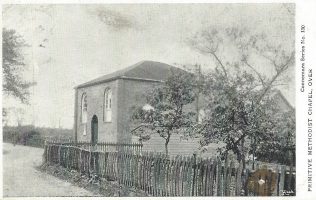Over Primitive Methodist Chapel
Cambridgeshire


Records give evidence that there were 9 members in a Methodist Society in 1824 and meetings were held in farm buildings before a house was registered in 1836. Over Chapel was built in 1848 and the word “REHOBOTH” on a tablet above the door which is a Hebrew word meaning “enlargement”. By 1857 a gallery was added to the Chapel so that more seats could be added to increase the seating to 140 due to the demand. In 1861 extra land was purchased and a school room was built where, in 1884, 112 children attended. By 1989 the chapel was going into decline and was in need of a total renovation which happened in 1990. The following year, the first service was held in the newly renovated hall and in 2013 it was reported that regular service was still taking place.
Sources;





Comments about this page
There is an active worship community in Over and we currently meet for Worship every Sunday at 6pm. The church hall is well used by the community. There are plans for a traditional primitive Methodist service in spring 2022 to celebrate the history and tradition of the building.
We have 7 members at the end of 2021 and ambitious plans for growth.
https://overmethodistchurch.org.uk/ is now our website which includes the history pages from the old pages and photographs of the extensive renovations.
I have found a fuller entry in my journal regarding my first two visits to Over. Here, from 1968, but referring probably to 1965-6, is the extract:
“With Cambridge University Methodist Society I was planned to preach at Over, in the Huntingdon Circuit. But our car broke down, and so we had to ’phone the “super” of the Cambridge Circuit to drive us to the village. He did so, but knew not where the chapel was. I almost entered the Baptist chapel, but my mistake was made known, and we hurried on till eventually we found the Methodist chapel – some twenty minutes late. By some mistake, another group was there conducting the service. When we burst in, (myself first, I think), my spectacles at once steamed over, so I could not see this. I announced that we would not take over the service. I suppose people must have wondered who we were – not least, the young man in the pulpit. I had to sit through a horribly non-evangelical sermon, as it struck me. But after the service, I stood up and suggested that some might like to stay behind and we could have some hymn singing. This we did, part at least of which I led. I remember one old lady of about eighty in tears afterwards, being so thrilled with the time we had. She was keen that we should go back, though we never did. Once I did set foot in that chapel again, at a Methodist Revival Fellowship meeting, though not to speak.”
Actually there is a mistake in my first comment: I actually visited the chapel three times. The one I forgot was a Methodist Revival Fellowship meeting in the mid 1960s. MRF meetings had a strong formative effect on my early Christian life, an effect which retains its influence to this day.
I have twice visited this beautiful chapel, and on the second occasion I came away wondering whether there might be a parable to learn here. On the first occasion, a Sunday, I and another man, whom I didn’t know, both believed we were engaged to preach there that evening. (It is a mystery how that should have happened in view of The Plan.) The other preacher had arrived first, so I sat in the congregation during the service instead of preaching. On a later date I was in the village again and had a camera with me, and as there was someone there (the cleaner, perhaps?), I asked whether I might come in, see again the pulpit where I had expected to preach, and – as the chapel is beautiful inside as well as out – take a photograph. I was told that was not acceptable, and I left without gaining admittance. So the door to Over remained closed to me a second time. A double disappointment.
Then I pondered: Isn’t this just how the Gospel came to Europe? Paul attempts to preach in Bithynia, passes by Mysia, goes on to Troas, and is called to move on to Philippi, where Lydia and her entire household believe, are baptised, and form perhaps the first church in Macedonia. Like Paul (and many others), we sometimes want to do something for good, perhaps the best, reasons, but the door won’t open, we do something different, and God blesses it: in fact, God planned it in the first place!
Add a comment about this page